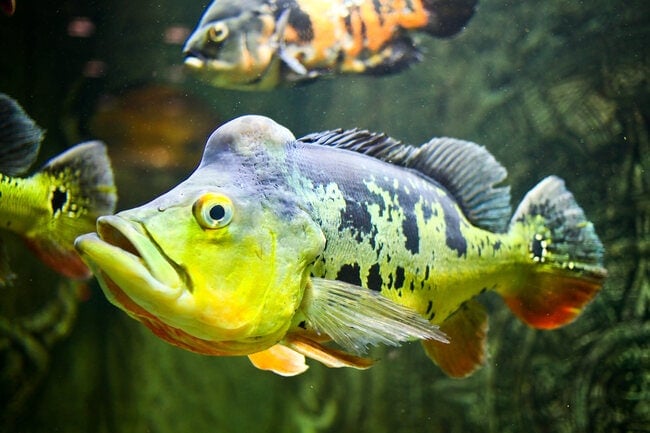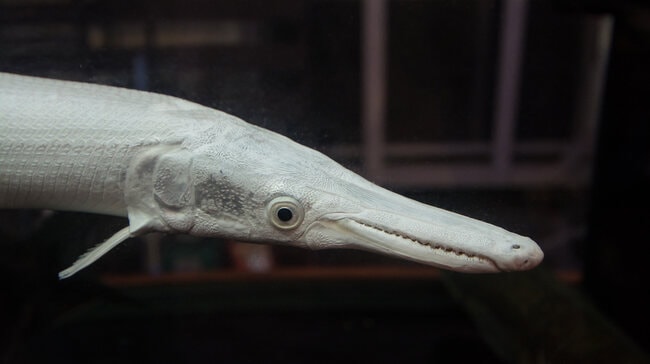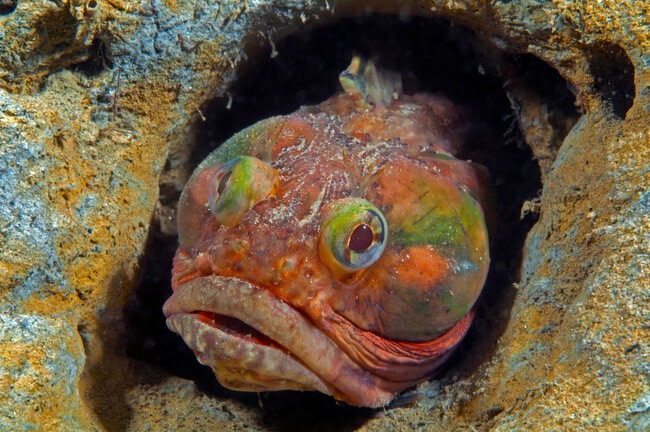13 Popular Weird Fish And How To Catch Them

There are over 1,000 species of fish in North America’s fresh water alone. Large and small mouth bass, trout, catfish, and salmon get a lot of attention, but there are numerous other popular, weird fish to “school” yourself on. Whether you’re a veteran angler or heading out for your first cast, these tips may inspire you to reel in something unusual!
1. American Shad Fish
Related to herring, the American Shad is a game fish that puts up a spectacular fight for anglers on both the East and West coasts. Like Salmon, Shad fish are anadromous, meaning they migrate up rivers from the sea to spawn, spending most of their lives in the ocean before their return to freshwater rivers where they were born. In the 1870s they were transplanted from the East Coast, making themselves a home in the Sacramento River and San Francisco Bay. They now populate the Columbia River between Oregon and Washington and other river systems in the region, spawning all the way from Baja California through Coastal Alaska and from Florida to Newfoundland on the Atlantic Coast, swimming pretty close to shore (30-45 feet) at varying depths, making them accessible to bank anglers as well as boaters who can set up in their migration lanes.
Shad are a great fish to reel new anglers into the sport, especially kids, and will be anywhere from 1-5 pounds, or larger at times. Shad start their run into freshwater as early as January through April in southern states and can last into August further North. Light rods and action tackle in low-current rivers and heavier tackle set-ups for more significant water flows.
2. Tarpon
One of the more exciting fish to watch, the tarpon is nicknamed ‘The Silver King’ from the bright flash that reflects from its body as it jumps. The prehistoric fish dates back 100 million years, and currently inhibits warmer waters; primarily the Gulf of Mexico in Florida. Female tarpon can grow as large as 300 pounds and reach over 8 ft long, with a lifespan up to 50 years, while the male counterparts live 30 years. These slow growing fish don’t reach reproductive maturity until 7-13 years of age.
Most tarpon fishing is done closer to shore, spawning from April to July. Tarpons are one of the few fish with a swim bladder, acting as a lung so they can breathe raw air, while still breathing through their gills like most fish. This unique breathing ability allow them to battle for so long, however periodically exposing them to fisherman when they roll on the surface to grab a breath of air.
Not sought after for food, these fish and are generally released back into the water. Tarpon fishing is often claimed to be the ultimate sport fish, with its explosiveness, endurance, and jumping ability. Their toothless mouths are hard, boney, and rough, so if you do happen to hook one, it takes a good hard hook-set to drive a hook home.
3. Peacock Bass
The Peacock Bass (pictured at the top of this article) is one of Florida’s toughest freshwater species, making it the ultimate game fish for anglers of all levels. Native to the Amazon, they were first introduced to the Florida’s lakes and canals in 1984 and are easily identified by their exotic pattern and coloring. Known for its hard-hitting strikes, aerial jumps, and line-stripping run, the peacock bass is especially fond of streamers and poppers, and prefer live fish bait and fish imitating baits, rarely hit plastic worms.
A light tackle works best. Once hooked they put on quite the show and their iridescent hues of yellow, orange, green, and blue make the pull even more satisfying. Peacock fish swim in the freshwaters of South Florida, with the best fishing done in Miami. Experts claim that shaded areas, such as under bridges, culverts, fallen trees, bridge pilings, rocky areas, and or other structures and during daylight hours is the best time to catch peacock bass, since they rarely bite in the early morning or at night.
4. Walleye
The Walleye is a freshwater fish native to most of Canada and the Northern United States. The name “Walleye” is derived from the fact that their eyes, like cats, reflect light. A light-gathering layer in their eyes allows the fish to see well in low-light conditions.
Most anglers are on the lookout for walleye at night when their major feedings occur. Their special eyes also allow them to see well in turbulent water, giving them an advantage over their prey. Walleye anglers search for waters that have a good “walleye chop” (i.e. rough water) to catch them. Their keen eyesight also grants them access to deeper regions in a lake, so anglers can look for them in deeper waters as well.
Walleyes grow to 30 inches in length and up to 15 pounds in weight, with southern populations growing faster and larger. Walleyes put up a good fight for anglers, while also delicious served up on a plate, making this a popular sporting-fish.
5. American Paddlefish
The American Paddlefish are among the largest and longest-lived freshwater fish in North America. This primitive fish, related to the sturgeon, is characterized by its distinct long, spatulate snout, numerous fill gill rakers, almost scaleless body, and a backbone extending into its upper lobe of its tail. It is sometimes referred to as a freshwater shark because of its tail and caudal fin resembling that of sharks.
The American paddlefish species is found in the Mississippi River basin, however due to overfishing, habitat destruction, and pollution populations have declined. Many states have implemented reintroduction programs and are now found in 22 states, in the Mississippi, Yellowstone, Ohio, and Arkansas Rivers. They occur mostly in deeper, slow-moving areas such as side channels, backwater lake, and tailwaters below dams and often stay near the bottom, congregating in holes near drop-offs. These fish are large enough to show up on most modern depth finders, making them easier to spot.
American paddlefish are filter-feeders with a diet consisting of microscopic zooplankton, which you can’t exactly dangle on a hook, so you will need to catch one by snagging—rather than using baits and lures. Some anglers also find some success “trolling” for paddlefish. If fishing from the bank, cast upstream as far as you can and immediately once the hook hits the water, begin reeling fast, jerking the pole sideways every 15-20 seconds.
Thirteen states allow commercial or sport fishing, however be sure to check your states regulations before you snag an America Paddlefish as they are protected under state and federal laws.
6. Chiselmouth
A large species of the minnow, the chiselmouth is a freshwater fish found in warmer parts of flowing pools, in runs over sand and gravel in creeks and smaller rivers, and in the margins of lakes of the Pacific Northwest. The adults feed primarily on diatoms, and algae, while juveniles feed on surface insects.
The chiselmouth is named for the hard plate on their lower jaw, with a straight cutting edge, reminiscent of a chisel, which is used to scrape rocks. Anglers use small pieces of worm or bread on a small hook with light presentation. If you happen to catch a large looking minnow in these areas, flip it over and check out its mouth. It may very well be a chiselmouth—a weird fish indeed.
7. Bull Red Drum
Also known as “Redfish” they acquired their name from the knocking or drumming sound made by the males’ swim bladders during spawning. Found up and down the east coast, from the Chesapeake to the Gulf of Mexico, this is one popular fish making most American anglers’ bucket lists. Big bulls move into the shore once waters are warm enough (60 degrees or more), September being prime time for large bull redfish, weighing in at 20-30 pounds.
Rather than fishing in inland shallows, move farther downstream to deeper inlets or bays, as these fish prefer deeper waters compared to their smaller kin. They are known to hide under ledges or drop offs waiting for schools of baitfish to swim, and favor bridges, jetties, and passes during spawning season.
Bull redfish are often bottom fish, which requires anglers to use a heavier action rod and enough weight to stay at the bottom. A blue crab, bunker, or other fresh bait is the best way to hook a monster. Alternatively, you can target redfish as they come up to feed, allowing you to use lighter tackle. Many anglers release the bulls (over 26 inches) back into the water, since the bull redfish is the natural brood stock for the species, resulting in more fertilized eggs.
8. Alligator Gar
Gars have been around since the late Jurassic period and is reminiscent of on alligator with fins. There are currently seven different gar species alive today, with the alligator gar being the largest species, reaching eight feet long. One successful characteristic is their ability to breathe air, allowing them to live in environments most conventional fish can’t. They are also covered in a tough hide, interlocking armor-plated scales, making it difficult to predators to penetrate. Gar eggs are toxic to mammals, birds, and invertebrates, but oddly not to other fish and some reptiles.

While you may eat Alligator gar meat, their eggs will most likely make you very ill. Found from southern Canada all the way down to Costa Rica, mainly in the eastern half of the United States, anglers have hooked an alligator gar using just about every possible rod and reel setup—from bowfishing to rod-and-reel, as well with passive gear such as juglines, limblines, and trotlines.
Conservation efforts for this large freshwater fish have increased the popularity of catch and release. Hooking one in the mouth and removing it prior to release provides the best way to ensure survival.
9. Atlantic Croaker
The Atlantic Croaker, also known as “hardheads” is a silvery fish with a pinkish glow that makes a loud “croaking” sound by vibrating strong muscles against its swim bladder. These bottom-feeders prey on bristle worms, mollusks, crustaceans, and small fish and are popular with recreational anglers in sounds and estuaries, over sandy or muddy bottoms, from Massachusetts to the Gulf of Mexico.
Young Atlantic croakers enter the Chesapeake Bay in August and begin their travel to freshwater creeks and low-salinity areas in the winter. Mature fish (2-3 years) inhabit deeper offshore water during the winter months and move into bays and estuaries during the remainder of the year.
Recreational anglers have luck catching croakers from spring through the fall using light tackle and natural baits, like shrimp, clams, bloodworms, and squid, while fishing at the bottom just before or after high tide in deep holes or channels.
10. Sarcastic Fringehead
This small and fearless saltwater fish, found off the coast of California and Baja California in the northeast Pacific Ocean, dons a large mouth and an aggressive territorial behavior, charging anything that approaches its burrow. Males are known for engaging in combative behavior when defending territories, where they wrestle by pressing their distended mouths against each other, resembling kissing. Females select mates based on this dominant determinant combat, where she will then lay her eggs in the male’s shelter, for him to protect from predators and other threats.

Sarcastic Fringeheads are “tube blennies” which means they live in tube-like structures or burrows created by other animals, such as burrowing clams or empty snail shells. They aren’t picky about their dwellings or their feeding habits and have even been found living inside soda bottles and eating a variety of prey, primarily squid eggs.
This quite weird looking fish may be found along open coastlines on sandy or hard muddy bottoms and are occasionally (and accidentally) caught by fishermen. Their distinctive markings and body make them easy to identify, however their teeth make them difficult to handle while unhooking.
11. Weakfish
The weakfish isn’t named after their fighting ability, but rather the tender, easily torn membrane of their mouth, which often causes a hook to tear free, allowing the fish to easily escape many anglers. Found along the east coast of North America, from Nova Scotia to Florida. Weakfish are also members of the Drum family, which make a loud drumming or croaking sounds by vibrating their swim bladder with special muscles. Growing to 12-18 inches on average, the weakfish is omnivorous and feeds on small schooling fish such as anchovies and menhaden, but are also known to eat crabs, shrimp, mollusks, and large zooplankton. Once it spots it prey it slowly approaches it and then quickly lunges at it with open jaws.
Weakfish can be caught at any level from the bottom to the surface by chumming on a boat or by trolling, jigging, or surf fishing. Conventional, spinning, and fly tackle can successfully be used on bridge, docks, and piers. They opt for warmer temperature waters, from 50-65 degrees, so targeting them within these temperatures when they are actively breeding will provide the greatest chances of securing a weakfish. They will begin to filter into Northeast bays in April.
A variety of lures and baits can be used to catch weakfish, depending on weather conditions, current speeds, and water depth. From bucktails to plastics to metal jigs, many anglers opt for smaller lures to catch larger weakfish. Natural baits such as squid strips, sand worms, and shrimp can add scent and lure to your jig. The weakfish’s finicky and shy behavior and weak mouth muscles provides a good challenge for anglers.
12. Muskellunge
The Muskellunge fish is one of the most sought after freshwater fish in North America. These large predatory and fast fish have gained them the nickname “the fish of a thousand casts” due to their difficulty in securing them. They thrive in large lakes and rivers, especially the Great Lakes and their surrounding rivers, as well as the Hudson Bay, St. Lawrence River, and the Mississippi River basins.
Muskellunge are oxygen-sensitive, therefore they avoid warmer temperatures, such as Florida waters, with less oxygen being available as the water warms. They prefer shallow vegetation areas with aquatic plant beds, with access to deeper pools. These fish have a substantial appetite, with a diet consisting of anything from minnows to gamefish, however they prefer suckers, perch, or cisco. Muskies don’t trick easily and are skilled at throwing the hook, making them known to be hard to hook. While they take both live and artificial bait, in the fall you will have more success with larger baits, while in the spring’s cooler water, they will take smaller baits.
To avoid loosing your lure, anglers advice using a wire leader to lure this tricky, weird fish. Start in areas near structures, drop-offs, rocks, sand bars, or shady shoreline, especially in the fall when they are likely to take both big and small bait. The best way to outsmart the Muskellunge is to keep your lure moving, as muskies tend to strike baits with ample movement.
13. White Sturgeon
The White Sturgeon is the largest freshwater species caught in North America. There is no mistaking this primitive looking fish, with its torpedo shaped body and bony plates running down its back, called scutes. They are anadromous, meaning they start their life in fresh water and spend part of it in salt water. However unlike salmon, they don’t die after they spawn, living for more than 100 years old and growing over up to 20 feet long and more than 1,500 pounds.
Found in coastal water from Alaska to Mexico, however white sturgeon primarily reside in large rivers and estuaries with shallow, slow-moving water. They are bottom-dwellers where they look for their food, consisting of insects, small fish, small crustaceans, and mollusks. These cartilaginous fish don’t need to see their food to eat, instead they use barbels, resembling whiskers, to feel and smell their food.
Anglers have better luck fishing for white sturgeon in low light, such as early morning or evening. During spawning season they will move to faster currents with temperatures warm enough to reproduce. White Sturgeon are usually fished from April to September, on the bottom of deep holes using cut bait, night crawlers, squid, herring, and shrimp. Barbless hooks with a sliding sinker rig are commonly used to hook these monsters and bait casting or spinning reel are commonly used.
Learn why August’s Full Moon is known as the Sturgeon Moon.
Join The Discussion
Have you ever seen a weird fish before? Which kind?
Share with your community here in the comments below!
Related Articles
August Full Moon – Sturgeon And Alternative Names

Natalie LaVolpe
Natalie LaVolpe is a freelance writer and former special education teacher. She is dedicated to healthy living through body and mind. She currently resides on Long Island, New York, with her husband, children, and dog.





